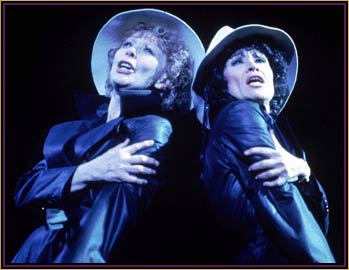 A vivacious singer, dancer, and actress — an exciting and explosive performer — Rivera was born to Puerto Rican parents and grew up in the Bronx. She started dancing when she was seven, and from the age of 11, trained for a career in classical ballet. After studying at the New York City Ballet via a scholarship from choreographer George Balanchine, in 1952 she turned from classical dance and joined the chorus of “Call Me Madam” on Broadway. Further chorus work in “Guys and Dolls” and “Can-Can” was followed by appearances in “Shoestring Revue,” “Seventh Heaven,” and “Mr. Wonderful” (1956). She rocketed to stardom in 1957 as Anita in “West Side Story,” and stopped the show nightly by singing and dancing herself into a frenzy to the whooping rhythms of “America.” She caused even more of a sensation when “West Side Story” opened in London on December 12, 1958; it is still regarded by many as the most exciting first night of the postwar years. Two years later she was back on Broadway as Dick Van Dyke’s secretary Rose, in the first successful rock ‘n’ roll musical, “Bye Bye Birdie,” and she re-created her role in London in the following year. A musical adaptation of “The Prisoner of Zenda” (1963), in which she starred with Alfred Drake, folded before it reached New York, but a year later, Rivera was acclaimed for her role as a gypsy princess in “Bajour” on Broadway.
A vivacious singer, dancer, and actress — an exciting and explosive performer — Rivera was born to Puerto Rican parents and grew up in the Bronx. She started dancing when she was seven, and from the age of 11, trained for a career in classical ballet. After studying at the New York City Ballet via a scholarship from choreographer George Balanchine, in 1952 she turned from classical dance and joined the chorus of “Call Me Madam” on Broadway. Further chorus work in “Guys and Dolls” and “Can-Can” was followed by appearances in “Shoestring Revue,” “Seventh Heaven,” and “Mr. Wonderful” (1956). She rocketed to stardom in 1957 as Anita in “West Side Story,” and stopped the show nightly by singing and dancing herself into a frenzy to the whooping rhythms of “America.” She caused even more of a sensation when “West Side Story” opened in London on December 12, 1958; it is still regarded by many as the most exciting first night of the postwar years. Two years later she was back on Broadway as Dick Van Dyke’s secretary Rose, in the first successful rock ‘n’ roll musical, “Bye Bye Birdie,” and she re-created her role in London in the following year. A musical adaptation of “The Prisoner of Zenda” (1963), in which she starred with Alfred Drake, folded before it reached New York, but a year later, Rivera was acclaimed for her role as a gypsy princess in “Bajour” on Broadway.
In the late ’60s, she toured in various productions including “Sweet Charity,” and also appeared in the 1969 film version with Shirley MacLaine. After more national tours in the early ’70s in musicals such as “Jacques Brel Is Alive and Well and Living in Paris” and “Kiss Me, Kate,” in addition to several straight roles, she co-starred with Gwen Verdon in the “sinfully seductive” “Chicago” (1975). John Kander and Fred Ebb wrote the score, and they also devised and developed Chita Rivera’s cabaret act, which included a number called “Losing,” a reference to the number of Tony Award nominations she had received. She gained one more nomination for her performance in “Bring Back Birdie” (1981), which closed after only four nights, and “Merlin” (1983) was also unsuccessful. Rivera was finally awarded the coveted Tony Award — and a Drama Desk Award — when she co-starred with Liza Minnelli in “The Rink” (1984), another of Kander and Ebb’s projects. Shortly afterward, she was involved in a serious car accident that “mangled my leg from the knee down.” After having 12 bolts inserted in the bones, she was back on Broadway, along with Leslie Uggams, Dorothy Loudon, and others, in “Jerry’s Girls,” a tribute to the composer Jerry Herman. During the rest of the ’80s, she performed in cabaret and continued to tour in America and other countries including the UK. In 198889, she joined the Radio City Music Hall Rockettes in a national tour of “Can-Can” that lasted for over a year. In 1991, she was inducted into New York’s Theater Hall of Fame, along with Kander and Ebb. She was subsequently widely applauded — and won London Evening Standard and Tony awards — for her outstanding dual performance as the movie star Aurora and the Spider Woman in Kander and Ebb’s musical “Kiss of the Spider Woman.” After 749 performances in Toronto, London, and New York, in November 1994 she set out on the show’s two-year road tour of North America.
Chita Rivera
- "Call Me Madam"
- "Bye Bye Birdie"
- "Can-Can"
- "Chicago"
- "Kiss of the Spider Woman"
- "Mr. Wonderful"
- "Nine"
- "West Side Story"
- Leonard Bernstein
- Bob Fosse
- Kander and Ebb
- Michael Kidd
- Nathan Lane
- Arthur Laurents
- Brian Stokes Mitchell
- Jerry Orbach
- Cole Porter
- Harold Prince
- Jerome Robbins
- Stephen Sondheim
- Charles Strouse
- Gwen Verdon
- Tony Walton
Source: Biographical information provided by MUZE. Excerpted from the ENCYCLOPEDIA OF POPULAR MUSIC, edited by Colin Larkin. © 2004 MUZE UK Ltd.
Photo credits: Photofest and Martha Swope


